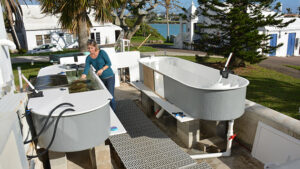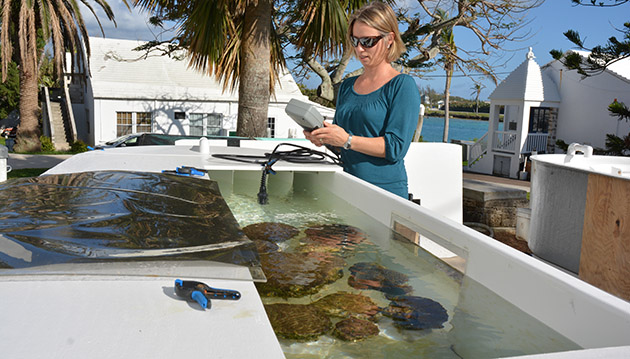BIOS Scientists Make Room for Flumes

When scientists study coral reefs, they are often interested in figuring out key components of reef health; specifically, primary production—or photosynthesis—and calcification, the rate at which new reef growth occurs. For decades this has meant time and labor-intensive fieldwork, with scientists documenting global reef condition and linking what they see underwater with lab-based experiments and measurements.
Today, the NASA-funded COral Reef Airborne Laboratory (CORAL) is changing the way scientists approach coral reef science. The multi-year project, now in its second year and about to embark on its second field campaign this month in Hawaii, is using remote sensing imagery collected by the PRISM (Portable Remote Imaging Spectrometer) instrument housed in the belly of an airplane. Using a combination of airborne data, in-water data, and laboratory measurements, CORAL scientists will develop a set of algorithms allowing them to estimate primary production and calcification from remote sensing images, such as those collected by PRISM.
The successful development of these algorithms would mark a significant change in how scientists study reef ecosystems, providing them with more insight into complex questions, including how a changing climate affects reef function.
To accomplish this, Eric Hochberg, a BIOS scientist and the principal investigator of CORAL, and his team are taking a cue from terrestrial, or land-based, science. For decades, biologists have used satellite images to estimate the primary productivity of terrestrial ecosystems, from grasslands to forests. In fact, primary productivity has been a standard product of MODIS, the Moderate Resolution Imaging Spectroradiometer, a key instrument aboard NASA satellites used to study earth since the 1990s.

Sawall uses a spectrometer to take measurements of light in the flume with a sample coral community.
“We’re not developing a new method,” Hochberg said. “We are applying it to a different environment.”
The method Hochberg uses relies on counting photons, or particles of light. If you can measure how many photons the plant community absorbs, and you know how efficient the community is at converting those photons into carbon through photosynthesis, then you can calculate the community’s primary productivity.
These same principles hold true for aquatic communities, including reef ecosystems. The key difference for reef communities, however, is measuring the primary productivity of communities that includes many different combinations of hard coral, soft coral, algae, and sand. Each has varying levels of photosynthetic pigments.
And, unlike terrestrial plant communities, reefs have another process that can be directly correlated with primary productivity: calcification. Reef scientists know that calcification increases in a roughly linear fashion as primary production increases, which means that calcification can be calculated from measurements of light availability and light use efficiency.
To begin making measurements of reef community production, Hochberg and BIOS postdoctoral researcher Yvonne Sawall spent several months constructing two flumes—large, rectangular fiberglass structures equipped with flowing seawater—outside the Reiss Conklin building on the BIOS campus. The flumes are equipped with two spectrometers to measure light in the system. One spectrometer is housed in the flume and measures how much light is reaching the bottom, while the other is pointed at the test community to measure what proportion of light is absorbed.
“To begin with, we won’t look at an entire reef community,” Sawall said. “But we will look at different components, including hard coral, the soft coral, and different types of algae. Then we can put them all together and study the community as we find it on the reef.”
Once this is accomplished, Hochberg and Sawall can begin changing environmental conditions in the flumes, such as temperature and water flow rate, to investigate the impact of these on primary productivity and light use efficiency. Calcification will be tracked by measuring changes in the system’s alkalinity, as coral releases carbon dioxide during the process, which then changes the pH of the surrounding water.
The goal is to build up a large database of efficiencies for various mixtures of organisms and environmental conditions, Hochberg said. Then, when the PRISM instrument makes its image of the reef, the scientists can look at each pixel in the image and use what they know about the benthic community at that point to determine the efficiency. Combined with measurements of how much light reaches the seafloor, this would allow a pixel-by-pixel representation of the reef community’s primary production and calcification rates.
Dan Schar, research technician at the University of Hawaii and co-principal investigator for CORAL, is conducting parallel experiments in a flume at the Hawaii Institute of Marine Biology. In addition to providing more data points to help develop a more accurate algorithm, these experiments also offer CORAL scientists an opportunity to compare reef communities between the Atlantic and Pacific environments.
Once the database is populated with information, the data will be passed along to Stéphane Maritorena, a CORAL co-principal investigator and researcher with the University of California at Santa Barbara’s Earth Research Institute. Maritorena will then use these data to further refine the algorithm that will further validate the PRISM remote sensing imagery as part of CORAL and serve as a tool for other reef scientists around the world.
